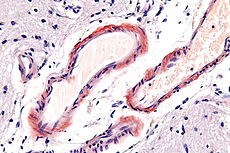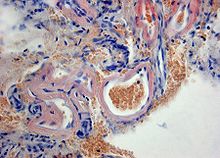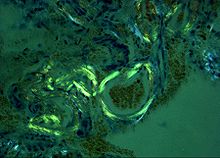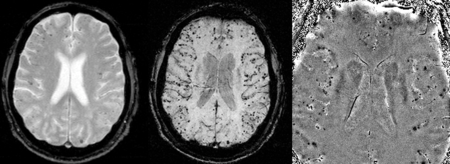- Cerebral amyloid angiopathy
-
Cerebral amyloid angiopathy Classification and external resources 
Micrograph showing cerebral amyloid angiopathy. Congo red stain.DiseasesDB 32874 MedlinePlus 000719 eMedicine neuro/628 MeSH D016657 Cerebral amyloid angiopathy (CAA), also known as congophilic angiopathy,[1] is a form of angiopathy in which amyloid deposits form in the walls of the blood vessels of the central nervous system.[2] The term congophilic is used because the presence of the abnormal aggregations of amyloid can be demonstrated by microscopic examination of brain tissue after application of a special stain called Congo red. The amyloid material is only found in the brain and as such the disease is not related to other forms of amyloidosis.
Contents
Causes
CAA has been identified as occurring either sporadically (generally in elderly populations)[3] or in familial forms such as Flemish, Iowa, and Dutch types.[4][5][6] Sporadic forms of CAA have been further characterized into two types based on deposition of amyloid β-protein (Aβ) in cortical capillaries.[7] In all cases it is defined by the deposition of Aβ in the leptomeningal and cerebral vessel walls.[8]
The reason for increased deposition of Aβ in sporadic CAA is still unclear with both increased production of the peptide[9] and abnormal clearance having been proposed as potential causes.[10][11] Under normal physiology Aβ is cleared from the brain by four pathways: (1) endocytosis by astrocytes and microglial cells,[12] (2) enzymatic degradation by neprilysin or insulysin[10] (3) cleared by way of the blood brain barrier[13] or (4) drained along periarterial spaces.[11] Abnormalities in each of these identified clearance pathways have been linked to CAA.
In familial forms of CAA the cause of Aβ build up is likely due to increased production rather than poor clearance.[14] Mutations in the amyloid precursor protein (APP), Presenilin (PS) 1 and PS2 genes can result in increased rates of cleavage of the APP into Aβ.[15]
An immune mechanism has also been proposed.[16]
Presentation
Amyloid deposition predisposes these blood vessels to failure, increasing the risk of a hemorrhagic stroke. Since this can be caused by the same amyloid protein that is associated with Alzheimer's dementia[17] such brain hemorrhages are more common in people who suffer from Alzheimer's, however they can also occur in those who have no history of dementia. The hemorrhage within the brain is usually confined to a particular lobe and this is slightly different compared to brain hemorrhages which occur as a consequence of high blood pressure (hypertension) - a more common cause of a hemorrhagic stroke (or cerebral hemorrhage).
Diagnosis
 Histopathology of cerebral amyloid angiopathy. Deposition of amyloid (red) in hyalinized vessel walls on congo red staining.
Histopathology of cerebral amyloid angiopathy. Deposition of amyloid (red) in hyalinized vessel walls on congo red staining.
 Birefringence in polarized light of amyloid material in blood vessel walls.
Birefringence in polarized light of amyloid material in blood vessel walls.
Susceptibility weighted imaging has been proposed as a tool for identifying CAA-related microhemorrhages.[18]
Biopsies also play a role in diagnosing the condition.[19]
Types
It is usually associated with amyloid beta.[20] This form has been associated with "Abeta-related angiitis".[21]
However, there are other types:
- the "Icelandic type" is associated with Cystatin C.[22]
- the "British type" is associated with ITM2B (also known as "BRI").[23]
Research is currently being conducted to determine if there is a link between cerebral amyloid angiopathy and ingestion of excessive quantities of aluminium, as occurred in the Camelford water pollution incident.[24]
References
- ^ Exley C, Esiri MM (July 2006). "Severe cerebral congophilic angiopathy coincident with increased brain aluminium in a resident of Camelford, Cornwall, UK". J. Neurol. Neurosurg. Psychiatr. 77 (7): 877–9. doi:10.1136/jnnp.2005.086553. PMC 2117501. PMID 16627535. http://jnnp.bmj.com/cgi/pmidlookup?view=long&pmid=16627535.
- ^ Revesz T, Holton JL, Lashley T et al. (July 2002). "Sporadic and familial cerebral amyloid angiopathies". Brain Pathol. 12 (3): 343–57. doi:10.1111/j.1750-3639.2002.tb00449.x. PMID 12146803.
- ^ Thanvi B and Robinson T. (September 2006). "Sporadic cerebral amyloid angiopathy—an important cause of cerebral haemorrhage in older people". Age and Ageing 35 (6): 565–571. doi:10.1093/ageing/afl108. PMID 16982664. http://ageing.oxfordjournals.org/content/35/6/565.full.
- ^ Hendriks L, van Duijn CM, Cras P et al. (June 1992). "Presenile demetia and cerebral haemorrhage linked to a mutation at codon 692 of the β-amyloid precursor protein gene". Nature Genetics 1 (3): 218–221. doi:10.1038/ng0692-218. PMID 1303239. http://publishing.eur.nl/ir/darenet/asset/5803/1091.pdf.
- ^ Grabowski TJ, Cho HS, Vonsattel JP et al. (June 2001). "Novel amyloid precursor protein mutation in an Iowa family with dementia and severe cerebral amyloid angiopathy". Annals of Neurology 49 (6): 697–705. doi:10.1002/ana.1009. PMID 11409420.
- ^ Maat-Schieman M, Roos R, van Duinen S. (December 2005). "Hereditary cerebral hemorrhage with amyloidosis-Dutch type". Neuropathology 25 (3): 288–297. doi:10.1111/j.1440-1789.2005.00631.x. PMID 16382777.
- ^ Thal DR, Ghebremedhin E, Rüb U, Yamaguchi H, Del Tredici K, Braak H (March 2002). "Two Types of Sporadic Cerebral Amyloid Angiopathy". Journal of Neuropathology & Experimental Neurology 61 (3): 282–293. PMID 11895043. http://journals.lww.com/jneuropath/pages/articleviewer.aspx?year=2002&issue=03000&article=00011&type=abstract.
- ^ Glenner GG, Henry JH, Fujihara S. (1981). "Congophilic angiopathy in the pathogenesis of Alzheimer's degeneration". Annales de Pathologie 1 (2): 120–129. PMID 6169353.
- ^ Li R, Lindholm K, Yang LB et al. (March 2004). "Amyloid β peptide load is correlated with increased β-secretase activity in sporadic Alzheimer's disease patients". Proceedings of the National Academy of Sciences of the United States of America 101 (1): 3632–3637. doi:10.1073/pnas.0205689101. PMC 373514. PMID 14978286. http://www.pubmedcentral.nih.gov/articlerender.fcgi?tool=pmcentrez&artid=373514.
- ^ a b Iwata N, Tsubuki S, Takaki Y et al. (February 2000). "Identification of the major Abeta1–42-degrading catabolic pathway in brain parenchyma: suppression leads to biochemical and pathological deposition". Nature Medicine 6 (2): 143–150. doi:10.1038/72237. PMID 10655101. http://www.nature.com/nm/journal/v6/n2/full/nm0200_143.html.
- ^ a b Weller RO, Massey A, Newman TA, Hutchings M, Kuo YM, Roher AE (September 1998). "Cerebral Amyloid Angiopathy : Amyloid β Accumulates in Putative Interstitial Fluid Drainage Pathways in Alzheimer's Disease". American Journal of Pathology 153 (3): 725–733. doi:10.1016/S0002-9440(10)65616-7. PMC 1853019. PMID 9736023. http://www.sciencedirect.com/science?_ob=ArticleURL&_udi=B6PJN-51TH968-B&_user=489277&_coverDate=09%2F30%2F1998&_rdoc=1&_fmt=high&_orig=gateway&_origin=gateway&_sort=d&_docanchor=&view=c&_acct=C000022679&_version=1&_urlVersion=0&_userid=489277&md5=1b956d613f8056b1286445138d81f353&searchtype=a.
- ^ Schenk D, Barbour R, Dunn W et al. (July 1999). "Immunization with amyloid-beta attenuates Alzheimer-disease-like pathology in the PDAPP mouse". Nature 400 (6740): 173–177. doi:10.1038/22124. PMID 10408445. http://www.nature.com/nature/journal/v400/n6740/full/400173a0.html.
- ^ Zlokovic BV (April 2005). "Neurovascular mechanisms of Alzheimer's neurodegeneration". Trends in Neurosciences 28 (4): 202–208. doi:10.1016/j.tins.2005.02.001. PMID 15808355. http://www.sciencedirect.com/science?_ob=ArticleURL&_udi=B6T0V-4FGX80H-1&_user=489277&_coverDate=04%2F30%2F2005&_rdoc=1&_fmt=high&_orig=gateway&_origin=gateway&_sort=d&_docanchor=&view=c&_acct=C000022679&_version=1&_urlVersion=0&_userid=489277&md5=02da7812480bc9f4b1dc0926715190e6&searchtype=a.
- ^ Thal DR, Griffin WS, de Vos RA, Ghebremedhin E. (June 2008). "Cerebral Amyloid Angiopathy and its relationship to Alzheimer's disease". Acta Neuropathologica 115 (6): 599–609. doi:10.1007/s00401-008-0366-2. PMID 18369648. http://www.springerlink.com/content/0211106350176618/fulltext.pdf.
- ^ Hardy J and Selkoe DJ (September 2002). "The amyloid hypothesis of Alzheimer's disease: progress and problems on the road to therapeutics". Science 297 (5580): 353–356. doi:10.1126/science.1072994. PMID 12130773. http://www.sciencemag.org/content/297/5580/353.long.
- ^ Yamada M, Itoh Y, Shintaku M et al. (July 1996). "Immune reactions associated with cerebral amyloid angiopathy". Stroke 27 (7): 1155–62. doi:10.1161/01.STR.27.7.1155. PMID 8685920. http://stroke.ahajournals.org/cgi/pmidlookup?view=long&pmid=8685920.
- ^ Thal DR, Griffin WS, de Vos RA, Ghebremedhin E (June 2008). "Cerebral amyloid angiopathy and its relationship to Alzheimer's disease". Acta Neuropathol. 115 (6): 599–609. doi:10.1007/s00401-008-0366-2. PMID 18369648.
- ^ Haacke EM, DelProposto ZS, Chaturvedi S et al. (February 2007). "Imaging cerebral amyloid angiopathy with susceptibility-weighted imaging". AJNR Am J Neuroradiol 28 (2): 316–7. PMID 17297004. http://www.ajnr.org/cgi/pmidlookup?view=long&pmid=17297004.
- ^ Greenberg SM, Vonsattel JP (July 1997). "Diagnosis of cerebral amyloid angiopathy. Sensitivity and specificity of cortical biopsy". Stroke 28 (7): 1418–22. doi:10.1161/01.STR.28.7.1418. PMID 9227694. http://stroke.ahajournals.org/cgi/pmidlookup?view=long&pmid=9227694.
- ^ Chao CP, Kotsenas AL, Broderick DF (2006). "Cerebral amyloid angiopathy: CT and MR imaging findings". Radiographics 26 (5): 1517–31. doi:10.1148/rg.265055090. PMID 16973779. http://radiographics.rsnajnls.org/cgi/pmidlookup?view=long&pmid=16973779.
- ^ Scolding NJ, Joseph F, Kirby PA et al. (March 2005). "Abeta-related angiitis: primary angiitis of the central nervous system associated with cerebral amyloid angiopathy". Brain 128 (Pt 3): 500–15. doi:10.1093/brain/awh379. PMID 15659428. http://brain.oxfordjournals.org/cgi/pmidlookup?view=long&pmid=15659428.
- ^ Nagai A, Terashima M, Sheikh AM et al. (2008). "Involvement of cystatin C in pathophysiology of CNS diseases". Front. Biosci. 13 (13): 3470–9. doi:10.2741/2941. PMID 18508448. http://www.bioscience.org/2008/v13/af/2941/fulltext.htm.
- ^ Vidal R, Frangione B, Rostagno A et al. (June 1999). "A stop-codon mutation in the BRI gene associated with familial British dementia". Nature 399 (6738): 776–81. doi:10.1038/21637. PMID 10391242.
- ^ "Government slammed for refusing to fund probe into death after one of worst water poisoning cases in British history". Daily Mail (London). 5 September 2008. http://www.dailymail.co.uk/news/article-1052696/Coroner-slams-Government-refusing-fund-probe-deaths-worst-water-poisoning-cases-British-history.html.
External links
Metabolic disease: amyloidosis (E85, 277.3) Common amyloid forming proteins Systemic amyloidosis Organ-limited amyloidosis HeartAANF/Isolated atrial amyloidosis- Familial amyloid neuropathy
- ACys+ABri/Cerebral amyloid angiopathy
- Aβ/Alzheimer's disease
Categories:- Vascular diseases
- Brain disorders
Wikimedia Foundation. 2010.

